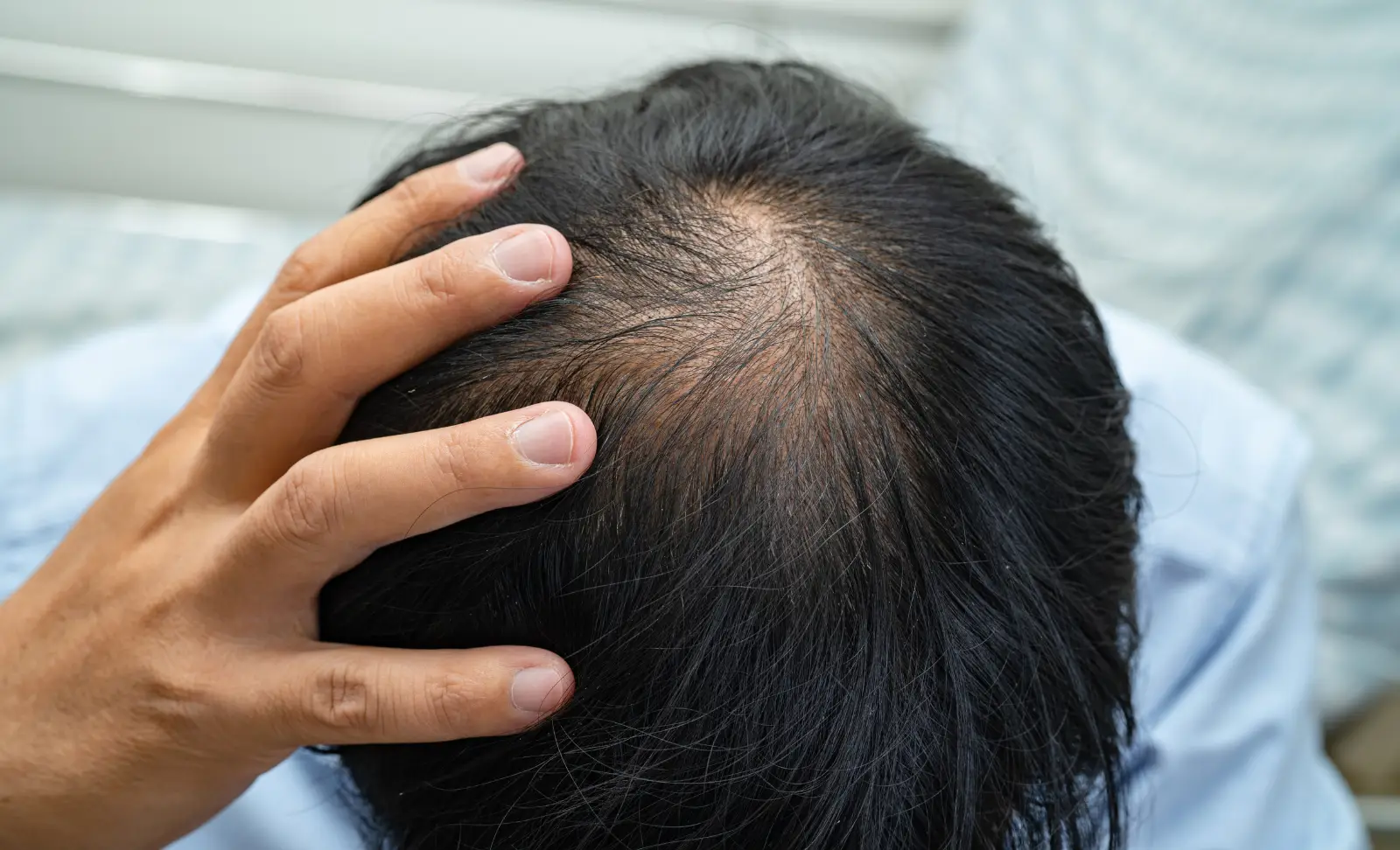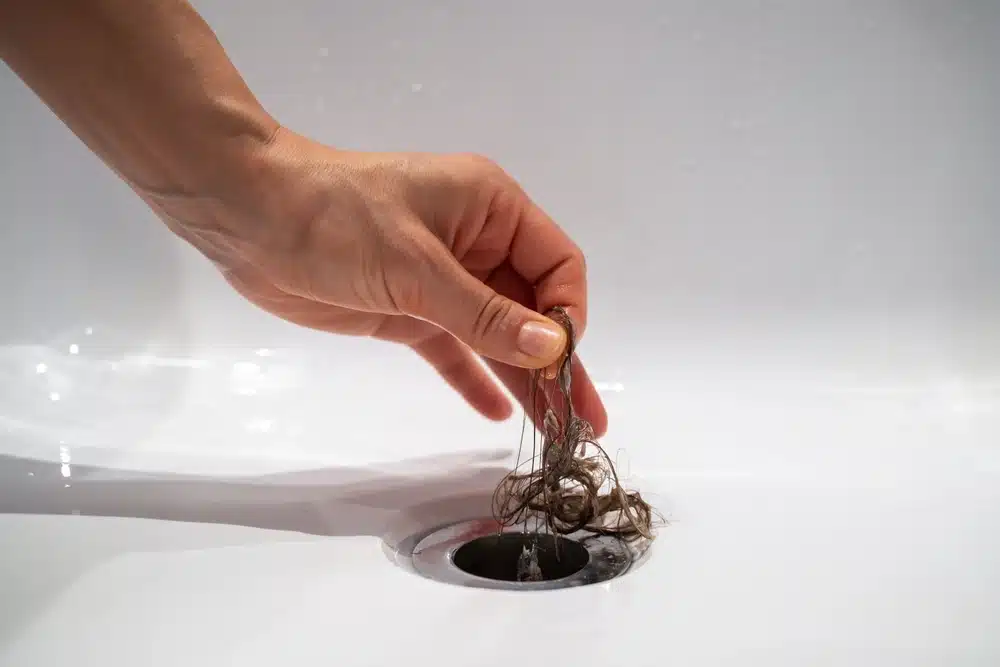Your appearance naturally changes throughout your life, including the hairs on your head. Where once you might have enjoyed a full head of healthy locks, you may one day discover more hair thinning than usual.
Androgenetic alopecia (male or female pattern baldness) is usually to blame, as it’s the most common cause of hair loss, affecting around one-third of all women [1] and two-thirds of all men [2] within their lifetimes. This often leads to hair miniaturisation, when the hair follicles shrink, leading to thinner, weaker strands. This then leads to people seeking out a hair loss treatment.
In this article, learn all you need to know about hair miniaturisation, including the most common causes, symptoms, and the best ways to treat it.
Understanding Hair Miniaturisation
To understand hair miniaturisation, it helps to know the anatomy of the hair. Every strand of hair comprises the hair shaft (the part you can see) and the hair root. The hair follicle is the part of the skin where the hair shaft grows – you cannot see hair follicles by looking at a person’s scalp.
Hair miniaturisation occurs when the hair follicle shrinks. As a result, the hairs that grow from the follicle are thinner, weaker, and more fragile. It can even lead to the hair falling out sooner, causing more significant hair loss. Hair miniaturisation is commonly associated with the loss of scalp hair, but it can also affect other terminal hairs, such as the hair on your chest, belly, underarms, and pubic area.
The Causes of Hair Miniaturisation
Find out the main causes of miniaturisation hair here.
Genetics
Some people are more predisposed to hair miniaturisation than others, and that is all due to genetics. Simply put, if your parents experience thinning hair over time, the same will likely happen to you. Androgenetic alopecia (male and female pattern hair loss) runs in the family and is a common cause of hair loss that leads to a receding hairline and balding scalp in men and thinning hair all over with a wider parting in women.
Hormonal Imbalances
Hormonal imbalances can affect the hair follicles, which leads to hair loss. For example, women who experience a decline in oestrogen during menopause often have the symptoms of thinning hair. Androgens are also commonly responsible for hair miniaturisation, especially DHT.
Stress
Stress can impact people both mentally and physically. Stress-induced hair loss is called telogen effluvium, which causes the hair growth cycle to go into the resting or hair shedding phase, leading to hair falling out and no new growth. [3] Sometimes, this also leads to hair miniaturisation, but it is often reversible.
Nutritional Deficiencies
Being deficient in specific nutrients can contribute to hair miniaturisation, particularly Vitamin D, Vitamin A, Vitamin B, zinc, and iron. [4] This is often reversible if you start upping your intake of whichever nutrient you have been deficient in – although there could be an underlying cause.
Medications
Certain medications can lead to hair miniaturisation. For example, many cancer treatments cause the hair to fall out and the follicles to shrink. Other medicines contributing to hair loss include anticonvulsants, antidepressants, certain steroids, and testosterone.
Immune System Conditions
Some immune system conditions can lead to miniaturised hairs and hair loss. These include alopecia areata, lupus, and psoriasis.
As you can see, there are several potential causes of hair miniaturisation. However, it should be noted that it is mostly due to androgenetic alopecia (female or male pattern baldness).
The Signs of Hair Miniaturisation
Do you think you have hair miniaturisation? It’s pretty much impossible to check your scalp to see if your hair follicles look any smaller than before. Instead, you need to look at hair loss symptoms to see if your follicles have shrunk. Here are some of the signs.
A Receding Hairline
One of the most common signs of hair miniaturisation caused by male androgenetic alopecia is a receding hairline – although this can also affect women. It refers to hair loss and thinning at the temples, often leading to a sort of M shape, where the hair stays forward towards the middle but recedes at the sides. You can check out the Norwood Scale to see how progressive your receding hairline is.
A Widening Parting
A widening parting is a common hair loss sign in women. Checking for it is simple – look at where your hair parts on the top of your head and notice the gap. If it’s wider than it used to be, that’s a sign of hair miniaturisation and hair loss.
Thinning Hair
Thinning hair is another clear sign of hair miniaturisation. Shrunken h
Breakage
If you notice more breakage than usual – and you haven’t suddenly changed your hair care routine – then there is a chance your hair follicles are shrinking. The hairs that grow from shrunken follicles are weaker and more prone to breakage.
Bald Patches
Visible bald patches on the scalp can be a sign of sudden hair loss, perhaps caused by alopecia areata. Not only is this a sign that your hair follicles may be shrinking, but also that they are becoming completely dormant and unable to grow new hairs in some sections.
A Visible Scalp
A visible scalp can sometimes be a sign of hair miniaturisation and hair loss. Of course, it depends on how much scalp you are used to seeing – some people with naturally fine or thin strands may find their scalp shows through anyway. However, if it is a new change, that could mean your hair follicles are shrinking.
How to Prevent Hair Miniaturisation
It is always best to prevent hair miniaturisation rather than experience it and have to treat it.
Eat a Healthy Diet: Your diet has a massive impact on the way you look. Your goal is to eat a highly nutritious diet that gets all the necessary vitamins and minerals for healthy-looking strands, including Vitamin A, zinc, and iron.
Manage Stress: To avoid telogen effluvium, try to manage your stress levels as much as possible. Little changes like being active, getting enough sleep, and taking enough breaks can have a serious impact.
Look After Your Scalp: Your scalp is responsible for healthy hair growth. Look after it and prevent follicle shrinking by using a mild shampoo, massaging the scalp regularly, and avoiding excessive styling products.
Sometimes, miniaturisation occurs through no fault of your own; you’ll experience it no matter your lifestyle. You can use a hair track app to keep up with your hair growth/loss and see whether you have experienced miniaturisation.
How to Reverse Hair Follicle Miniaturisation
Reversing hair miniaturisation does not have to be tricky. Most of these treatment options work well for androgenetic alopecia and other common types of hair loss.
Minoxidil: Minoxidil is a highly effective topical hair medication that aims to treat most types of hair loss. It works by stimulating the hair follicles through increased blood flow, which can help them activate once more and reverse shrinkage. It needs to be used daily for results to stick – otherwise, the user may experience hair miniaturisation again even after good results.
Finasteride: Finasteride lowers the DHT levels in the body, the hormone responsible for male androgenetic alopecia. Finasteride effectively stops this hormone from shrinking the follicles, allowing the hair to grow through healthily once more.
Scalp Massages: A non-medical way to reverse hair follicle miniaturisation is to give yourself a scalp massage. This simple massage can stimulate blood flow to the scalp and the follicles, which means the follicles receive more nutrients and oxygen from the body. In turn, they are strengthened and likely to grow healthier hair.
Platelet-Rich Plasma Therapy: PRP injections are a clinical, non-surgical treatment option that uses a patient’s blood to encourage hair growth. The growth factors and other components in the plasma help activate the hair follicles, reversing the shrinkage and boosting growth.
Hair Transplants: A hair transplant is an FDA approved, minimally invasive surgery that involves taking healthy hair follicles and placing them into the area that no longer grows healthy hair. These new follicles take root, allowing the patient to enjoy a healthy head of hair once more. It’s a surgery with a high success rate and works excellently for androgenetic alopecia.
Final Thoughts
If your scalp once produced healthy hairs, but now you’ve noticed thinning patches and hair loss, the chances are your hair follicles have shrunk. That can be due to several types of hair loss, the most common being androgenetic alopecia. Not all hope is lost, though – there are ways to treat androgenetic alopecia (and, in turn, hair miniaturisation), such as using medications like minoxidil and undergoing hair transplant surgery.
Are you interested in learning more about hair transplants? Head to our patients gallery to view before and after images of our patients.
Sources:
- https://www.health.harvard.edu/staying-healthy/treating-female-pattern-hair-loss
- https://my.clevelandclinic.org/health/diseases/24515-male-pattern-baldness-androgenic-alopecia
- https://www.ncbi.nlm.nih.gov/books/NBK430848/#:~:text=Telogen%20effluvium%20is%20the%20excessive,and%2015%25%20is%20telogen%20hair.
- https://www.health.harvard.edu/diseases-and-conditions/vitamins-minerals-and-hair-loss-is-there-a-connection#:~:text=If%20you%20have%20hair%20loss,is%20confirmed%20by%20laboratory%20tests.



